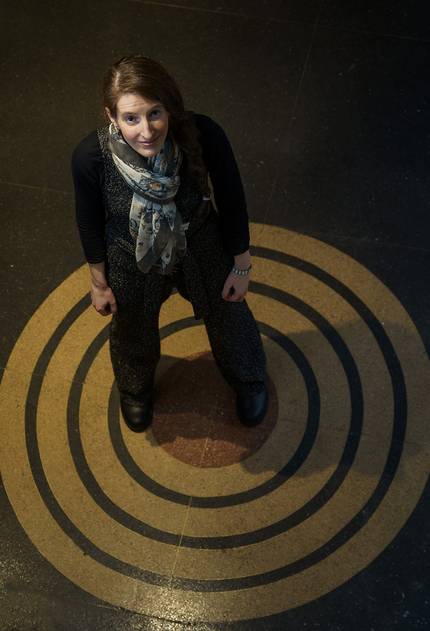“Early diagnosis of Alzheimer’s is key.”
Neurologist Miren Altuna Azkargorta (Zarautz, 1988) investigates degenerative brain diseases, especially Alzheimer’s. He also did his Ph.D. on the subject, and he provides care because, as a young man, he chose the disorders that usually affect the elderly, in research and in the clinic. In any case, it was a natural decision for him. On the one hand, because he has always had a passion for research, and precisely because his thesis director researched epigenetics in different fields, including Alzheimer’s. On the other hand, they have had cases of Alzheimer's in the family and the like, which also gave him something to think about. But he insists that he was motivated above all by being able to contribute to what we know little about.
Thanks to the path that is being followed by this impulse, we now know more about Alzheimer’s and the quality of life of patients has improved. Prudently, he did not hide the fact that much remained to be done, but he also gave reasons for hope.

How has the understanding of Alzheimer’s and other cognitive impairments associated with old age changed in recent years?A
lot has changed, and the first thing I want to clarify is that the development of dementia is not due to aging. Behind cognitive decline, in addition to Alzheimer’s, there are other diseases that we often confuse. It is important to distinguish them, because each one has its own characteristics.
We all need to have some basic ideas. First, what does it mean to be cognitively healthy? It is that certain skills — memory, attentiveness, level of speech and orientation — are expected in view of our age, level of study and profession, and that we believe that we are doing well compared to those around us.
If problems appear in these abilities, but there is no loss of autonomy, there is slight cognitive impairment. We believe that the diagnosis must be made at this stage; to make it in dementia is a terrible mistake. This is the main change in Alzheimer’s and neurology in the last 10-15 years.
And what is called mild cognitive impairment?
Mild cognitive impairment is when, objectively and using appropriate tests, a person is found to have lower than expected performance in memory, speech level, ability to orient, or attention level, and is also able to lead a normal lifestyle. You can work with a mild cognitive impairment, you can drive... If the diagnosis is made during this time, the person is able to make decisions for the future. That's why it's so important.
In dementia, however, there are difficulties in living a daily life. For example, in mild dementia, the person is able to dress alone, goes out on the street; but for example, he has problems to carry his money correctly or cook.
What were formerly considered senile dementias?
Most of the so-called senile dementia cases, 50-75%, are Alzheimer’s. There are many, but not all. Therefore, it is important to know if it is Alzheimer’s or another disease, since the treatment options are different and the prognosis is also very different.
After Alzheimer’s, the second type, between 20 and 30%, is vascular, that is, associated with vascular risk factors: stress, cholesterol, diet, sedentarism... And today, we know that we can greatly reduce this risk.
Then, in 10-25% of cases, there is dementia of Lewy bodies. Like Parkinson's, synuclein is associated with protein accumulation. The difference is that in Parkinson’s, movement problems are first explained and then cognitive impairment, while in Lewy disease it is the other way around.
Finally, in 10-15%, there is frontotemporal dementia, in which neuronal degeneration occurs in the frontal and temporal lobes. It usually occurs in younger people, and the way it is explained can be varied, but it usually affects behavior more than cognition.
However, in some cases, in addition to Alzheimer's, the patient may also have signs of vascular and Lewy disease.
On the other hand, people with depression or severe anxiety may also have attention problems. And sometimes, along with the above-mentioned conditions, the patient may also develop depression. In addition, drugs prescribed to treat these or other problems may have side effects at the precautionary level.
Therefore, it is essential to carry out a complete study and to keep a good track of the patient's condition.
Is the effect of the drugs so obvious?
Yes; during the test, it is essential to know which medicines you take. For example, the consumption of highly benzodiazepines is alarming; in Spain, it is the highest in the world. Many people take them, and for a long time, and they should not be taken more than three months. This is the responsibility of society and of doctors. What's going on? That they're very cheap drugs. And if you have seven minutes in a consultation to see a patient who tells you that he is sleeping badly, it is easier to put a pill than to study it well and look for the right solution. That's the reality. And we know that among all the damage they cause is confusion.
In addition, we also have COVID-19, which also causes cognitive symptoms. And let’s be clear: in those who are vaccinated, the risk is much lower. Other infections can also exacerbate an existing problem, such as pneumonia or the flu can make care or counseling worse. COVID-19, however, in addition to what the infection entails, also affects the brain. However, it is still too early to know the long-term implications for the development of neurodegenerative diseases.
On the contrary, the importance of sleep is known. During sleep, the toxic compounds in the brain are washed away. And there's a connection between sleep, epilepsy and Alzheimer's. In fact, in Alzheimer's disease, the risk of epileptic seizures increases 10-fold, and sleep deprivation and sleep apnea exacerbate these disorders.
And amyloid accumulation is one of the hallmarks of Alzheimer's, right? Which one more?
That's what it is. Nowadays, the diagnosis is not clinical, but biological. And we consider two proteins: amyloid and tau. These two must be there to confirm that it's Alzheimer's.until 2000, the only way to confirm this was through an autopsy. In recent years, however, we are able to diagnose it in consultation visits with a reliability of more than 90%.
You also said that this diagnosis should be made before the onset of the dementia phase.
The fact is that there is a presymptomatic phase: despite the existence of the disease, there are no signs. This phase can last up to 20 years. Then comes the phase of mild cognitive impairment, which we call prodromal Alzheimer’s, which has a very variable duration: in some people it lasts two years and in others it lasts 7-8 years. This can be influenced by intellectual activity, health status and genetic reasons. But above all, it affects what we do, our habits of life.
The last phase is dementia, where there are also several stages, from mild dementia until the patient is unable to get up from the bed on his own.
How is the diagnosis made?
First, a clinical interview is conducted; not only with the person suspected of having cognitive impairment, but also with someone close to him who knows him well. In fact, usually, when a cognitive disorder is explained, those around you become aware of it earlier than you are.
On the other hand, it is essential to know the previous history of this person. Because the performance I expect from a person is not the same as the level of study and career path that I'm going to require.
In addition, a physical exam should be done to see if there are any signs of Parkinson's disease or if you have had a stroke... So we make a diagnosis. The tests that follow are to confirm or dismiss these reasons.
In this regard, neuropsychological examination can help a lot. In fact, the questions we ask during the consultation are quite simple, as they are designed to diagnose dementia. Therefore, a person with mild cognitive impairment will usually respond well.
The neuropsychological examination is carried out in greater detail, is more demanding and is corrected by the level of education of the person, his/her profession, age and sex.
In addition, what other resources and criteria do you use to diagnose Alzheimer’s?
Symptoms are essential. The first symptom, not always, but yes, in most cases, is memory problems; close memory: forgetting where we have left the important things, meaningful conversations...
There are other symptoms that show us that it is Alzheimer's. One of them is clearly a logopenic aphasia. What is that? Well, if we ask a person to repeat a sentence of three words, he does it well, but if it is five or six words, he is not capable. He has difficulty finding words, and because he has communication problems, he stays at home.
Another type of symptom affects vision: posterior cortical atrophy. Those who have it, in front of a ladder, do not know how to throw their leg, because they cannot calculate the height of each step; or they do not see a certain object, even in front of it. When they become aware of the problem, they go to the ophthalmologist, but it has nothing to do with the eye, but with Alzheimer’s.
In addition, there are behavioral, behavioral symptoms that vary depending on the stage of the disease. In the beginning, being aware of the problems they have, the most common are the lack of enthusiasm and sadness; or anxiety and anger with oneself. Then comes irritability and aggressiveness. And at the end, they are slowed down again and the reactions are completely primary, for example, crying.
This is where the diagnosis of Alzheimer’s is made, of course.
Of course, of course. All of these symptoms are associated with neuronal damage that can be detected by biomarkers. This has been the biggest breakthrough in this area in recent years. This has allowed a radical change in the way patients are treated.
What are biomarkers?
Biomarkers allow us to confirm the presence of amyloid and tau proteins. This allows us to conclude that the cognitive problems that have been detected are due to Alzheimer's disease with a high degree of probability. And the key is that we can detect these biomarkers before the dementia phase.
Today, we know how the levels of these proteins change over time. First appears the amyloid, and after many years the tau protein is explained. In addition, we know whether these two proteins, in addition to accumulating, cause neuronal death or not.
They need to be measured in the phase of mild cognitive impairment, and in research, we can measure them earlier. But we don’t do it in the clinic because we can confirm that a person has amyloid and taua, both of which are still four or five years away from the onset of symptoms. However, we are unable to offer anything to prevent these symptoms from appearing. Therefore, it is unethical to report it, because during this time many other things can happen to it: an accident, cancer...
If, on the other hand, a person goes to the office because they are starting to have cognitive problems, with a lumbar puncture, and thanks to the biomarkers, we can tell them if they are related to Alzheimer's with a probability of 90%. And if it comes out negative, it's not Alzheimer's with 90% certainty.
However, there is a limitation and it is structural: there are not enough neurologists or infrastructure to perform lumbar punctures. For this reason, a great effort has been made to achieve the detection of these biomarkers in the blood, and we believe that within five years, in clinical practice, we will be able to detect them in the blood. At this time, the problem there is technical, because the concentration of these substances in the brain is very low in the blood. Therefore, highly advanced technology is needed, and for the moment in the Basque Country, only the Achucarro Foundation and CIMA in Navarre have this technology. But he'll come.
What about genetic testing? To what extent do genes determine the risk of Alzheimer’s disease?
In only 0.1% of cases, Alzheimer’s is caused by genes. Wait, there are genetic risk factors, but they don't weigh more than modifiable factors. That is, the genes have the same weight as hypercholesterolemia, hypertension, alcohol, tobacco or other factors associated with lifestyle habits, with the exception of the aforementioned 0.1%. And within this 0.1%, the highest percentage is that of Down's syndromes.
Well, this connection between Down's syndrome and Alzheimer's is not very well known in society, is it?
Well, maybe not. We see fewer and fewer children with Down syndrome; and more and more adults, whose life expectancy has skyrocketed in recent years. From the 1980s to the 1990s there was a huge leap in life expectancy, as heart surgery began in the first year after birth. This prevented the death of the children. On the contrary, it has barely increased since 2000 and is still 20 years less than that of the general population.
Senile phenomena also occur 20 years earlier in people with Down syndrome. And a person with Down's syndrome who lives long enough is sure to develop Alzheimer's. By the age of 40, these people will have signs of Alzheimer’s in their brains, and by the age of 60, 90% will have dementia. Today, in Down's syndromes, Alzheimer's is the first cause of death.
For all these reasons, we are working, both in research and in the clinic, to help these people. I really like this job, it’s hard, but it’s beautiful.
Finally, what progress has been made in the treatments?
The drugs available in Europe are 20 years old and were initially said to slow the disease. That's not true. They do the favor, yes, especially if they are placed in the first phase; and especially in Lewy disease, not so much in Alzheimer's.
The best means of slowing down the disease currently available to us on a global scale are those aimed at promoting healthy lifestyles. In any case, the anti-amyloid protein drugs have also left us room for hope. In fact, the FDA [U.S. Food and Drug Agency], in 2023, approved the drug Lecanemab for use in Alzheimer’s disease, both in the prodromal phase and mild dementia; previously, in 2021, it did the same with the drug Aducanumab, although conditionally; and it is expected that soon Donanemab will join this list. The biological benefit of these drugs, which is the removal of amyloid in the brain, is clear. In contrast, the clinical benefit is lower: the treatment of 18 months slows the symptoms of the disease by a maximum of 6 months.
So I want to make it clear once again: by changing our habits of life, we can significantly change our risk. These lifestyle habits are associated with eating, exercise, social relationships, not taking too much medication, not consuming alcohol and tobacco, intellectual activity, and sleeping.
The study, called Finger, showed that initiatives that promote these vital habits have significant benefits. Thus, the Cita-Alzheimer Foundation launched a pilot initiative in Beasain based on the Finger study, whose benefits were already clear in a year. So now, through Cita Go-On, we want to show that a healthy lifestyle program and risk control reduces your risk of Alzheimer’s. those between 60 and 85 years old are invited to participate.
Buletina
Bidali zure helbide elektronikoa eta jaso asteroko buletina zure sarrera-ontzian











